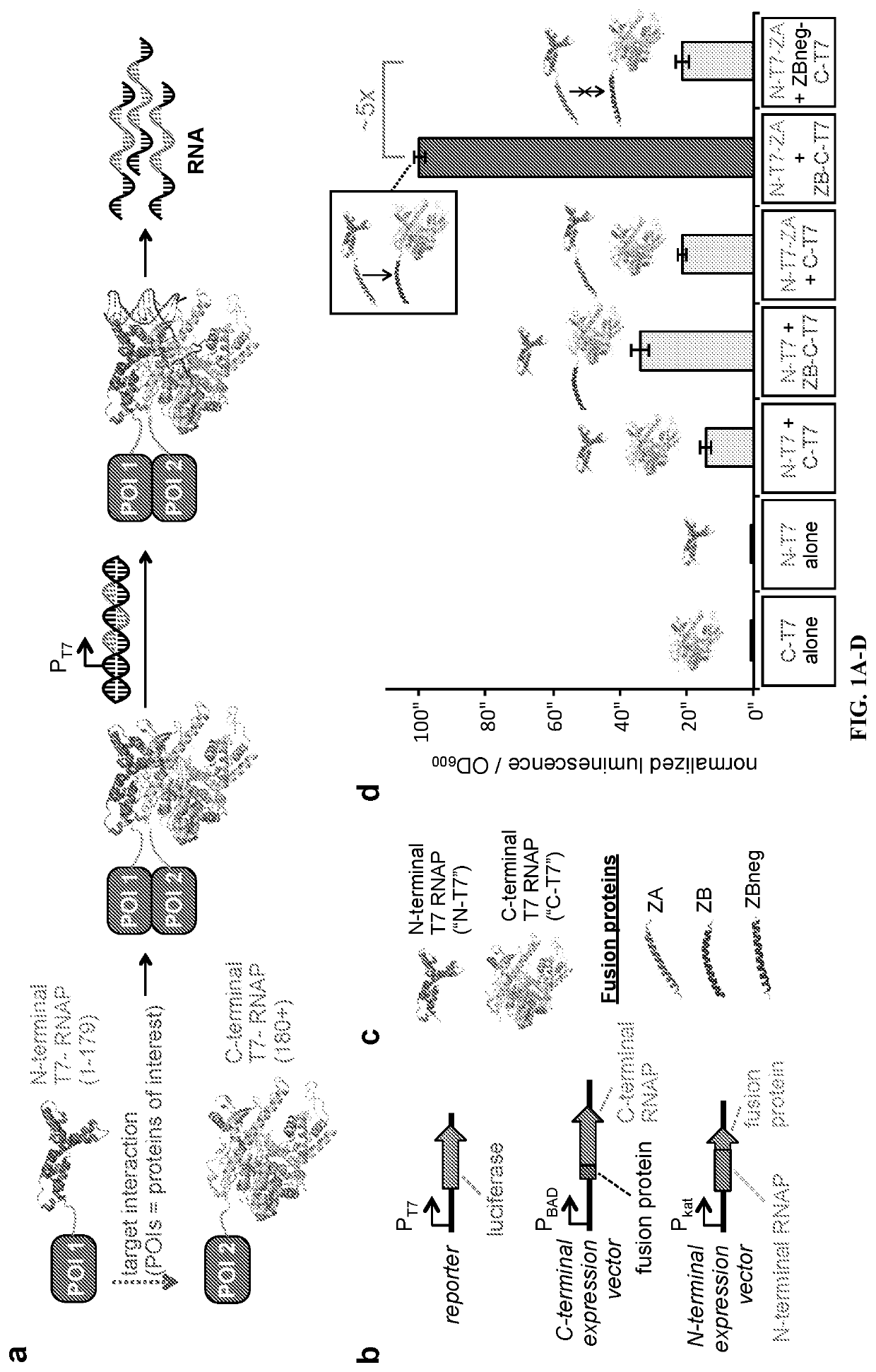Proximity-dependent split RNA polymerases as a versatile biosensor platform
a biosensor and proximity-dependent technology, applied in the field of chemistry and medicine, can solve the problems of lack of signal-to-noise, n-hybrid” and aptamer-based systems, and the requirement for extensive optimization for each new input, so as to reduce interactions, improve the effect of interactions and reduce immunogenicity
- Summary
- Abstract
- Description
- Claims
- Application Information
AI Technical Summary
Benefits of technology
Problems solved by technology
Method used
Image
Examples
example 1
Biophysical Feasibility of Proximity-Dependent Split RNAP
[0100]Two key biophysical criteria for the inventors' proposed AR strategy are that fused protein domains do not sterically interfere with the split RNAP and that interactions of fused domains can influence the RNAP assembly process. The inventors chose to deploy T7 RNAP split at position 179 because, 1) the N-terminal half is as small as possible, 2) structural data indicates this position is solvent exposed and removed from the DNA-binding face of the protein, and 3) mutations that influence DNA promoter specificity are C-terminal to this position (Shis & Bennett, 2013; Dickinson, et al., 2013; Ellefson, et al., 2014). First, the inventors validated that the two RNAP halves spontaneously assemble using an E. coli luciferase reporter system (FIG. 1b, c, d; FIG. 5). Next, the inventors utilized known leucine zipper peptides that form a tight interaction with one another (ZA and ZB) (Ghosh, et al., 2000; Magliery, et al., 2005)...
example 2
Development of a Continuous Evolution System to Optimize Split RNAPs for PPI Detection
[0101]In order to develop split RNAPs as a platform for biosensor design, the RNAP assembly process needs to be more dependent on fused interaction partners. This involves tuning the affinity of the interface between the two RNAP halves while maintaining all of the other aspects of RNAP enzymatic function, including DNA binding, nucleotide binding, and RNA synthesis. Such a protein engineering problem presents substantial challenges, which can in principle be overcome by molecular evolution. Therefore, the inventors chose to deploy PACE, a rapid evolution system (Esvelt, et al., 2011), which has been used to evolve RNAP promoter specificity, protein-DNA interactions, protease activities, and protein-protein interactions (Packer & Liu, 2015; Dickinson, et al., 2013; Esvelt, et al., 2011; Badran, et al., 2016; Carlson, et al., 2014; Dickinson, et al., 2014; Hubbard, et al., 2015; Leconte, et al., 201...
example 3
Evolution of a Proximity Dependent Split RNAP Using PACE
[0104]After cloning and validating the system components, the inventors initiated PACE. The positive and negative selection pressures were modified by carefully tuning the system components (FIG. 2b, FIG. 6) and the progress of the evolution was monitored by activity-dependent plaque assays and genetic analysis of the evolving phage (Supplementary FIG. 4). Specifically, the inventors altered the concentrations of the on-target and off-target interactions, and the strength of selection of the RNA output, by tuning the ribosome binding sites (RBSs) controlling each system component. After each 3-4 days of PACE on a given target, the inventors would use activity-dependent plaque assays to decide the subsequent evolutionary targets. This process continued for 29 days, after which time the N-terminal RNAP converged on two main genotypes, a 6-mutation (N-29-1) and a 7-mutation (N-29-8) variant (FIG. 2c), with several of the mutations...
PUM
| Property | Measurement | Unit |
|---|---|---|
| size | aaaaa | aaaaa |
| molecular weight | aaaaa | aaaaa |
| volume | aaaaa | aaaaa |
Abstract
Description
Claims
Application Information
 Login to View More
Login to View More - R&D
- Intellectual Property
- Life Sciences
- Materials
- Tech Scout
- Unparalleled Data Quality
- Higher Quality Content
- 60% Fewer Hallucinations
Browse by: Latest US Patents, China's latest patents, Technical Efficacy Thesaurus, Application Domain, Technology Topic, Popular Technical Reports.
© 2025 PatSnap. All rights reserved.Legal|Privacy policy|Modern Slavery Act Transparency Statement|Sitemap|About US| Contact US: help@patsnap.com



